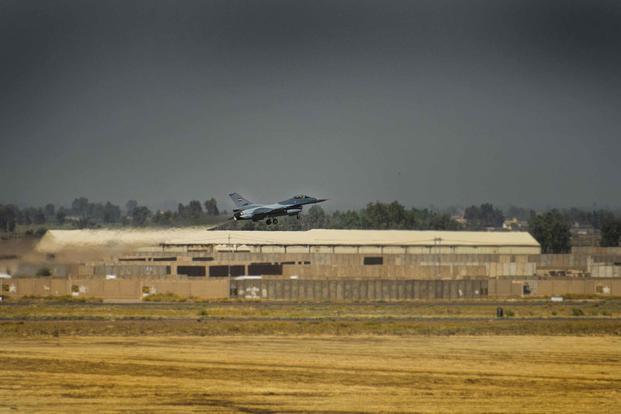Rocket attacks hit Baghdad's "Green Zone," which houses the U.S. Embassy and Balad Air Base where U.S. troops are stationed, on Saturday, Iraq's military and state media reported.
There were no immediate reports of casualties. The attacks came as the U.S. bolsters forces in the region in response to Iranian threats to avenge the killing of Iranian Quds Force Maj. Gen. Qasem Soleimani at Baghdad's International Airport this week. The Pentagon later took responsibility for his death.
At least one rocket fell on a parade ground in the Green Zone, causing no damage or casualties, the reports said.
Also Saturday, several rockets fell at the gates of Balad Air Base, which is used jointly by the U.S. and Iraqi militaries, the reports said.
Related: Thousands of Marines Head to Middle East on Navy Ship as Iran Pledges Retaliation
The Iraqi Security Forces' Twitter account said that "a number of rockets landed targeting" the Green Zone and Balad "without casualties."
There were no immediate claims of responsibility for the attacks.
Earlier, thousands of mourners, including acting Iraqi Prime Minister Adil Abdul-Mahdi, marched in a procession to honor the deaths of Soleimani and Abu Mahdi al-Muhandis, leader of an Iranian-backed Shiite militia, who also was killed in the U.S. strike at the airport.
On Friday, Joint Chiefs Chairman Gen. Mark Milley said U.S. intelligence had solid evidence of Soleimani's plans for a campaign of devastating attacks on Americans before the Pentagon launched the strike that killed the widely feared head the Quds Force, a branch of Iran's Islamic Revolutionary Guard Corps (IRGC).
In a meeting late Friday with a small group of defense reporters at the Pentagon, Milley said the U.S. must now brace for an unpredictable response from Iran after eliminating an implacable foe of its presence in the region.
"Is there risk? Damn right, there's risk. But we're working to mitigate it," he said, according to The Washington Post, The New York Times and other outlets invited to Milley's office.
"We fully comprehend the strategic consequences" of President Donald Trump's order to launch the strike to kill the 62-year-old Soleimani at Baghdad's International Airport on Thursday, Milley said. Iraqi state media reported the attack was carried out by missiles launched from a drone at Soleimani's two-vehicle convoy.
In another precautionary move, the first contingents of about 3,000 additional paratroopers from the Army's 82nd Airborne Division, based at Fort Bragg, North Carolina, began boarding aircraft Saturday at Pope Army Airfield to deploy to Kuwait, the Fayetteville Observer reported.
On Wednesday, about 750 soldiers from 2nd Battalion, 1st Brigade Combat Team, of the 82nd boarded C-17 Globemaster aircraft to deploy to Kuwait following Tuesday's anti-American demonstrations at the U.S. Embassy in Baghdad.
In a statement Friday after Soleimani's death was confirmed, a Pentagon spokesperson said the entire 1st Brigade Combat Team would begin deploying to Kuwait as early as Saturday.
In his briefing to reporters Friday, Milley said there was "clear, unambiguous" evidence picked up by U.S. intelligence of Soleimani's plans for attacks on Americans, but he was not specific on what the intended targets included.
Before briefing members of Congress on Friday, a senior Defense Department official, speaking on background, was equally vague on Soleimani's plans.
The official cited a series of rocket attacks on U.S. installations in Iraq in recent months, which were blamed on the Iranian-backed Kataib Hezbollah (KH) militia. Those attacks included one on the "K-1" U.S.-Iraqi base near north-central Kirkuk that killed an American contractor and wounded at least three U.S. troops.
In response, the U.S. launched strikes by F-15 Strike Eagle fighters against three KH locations in Iraq and two in Syria. The KH claimed the attacks killed 25 fighters.
The senior defense official declined comment on the attack Soleimani was planning but said the decision to kill him "was based on a presidential direction, given the ongoing planning and threats we saw in the region."
On CNN Friday, Secretary of State Mike Pompeo also did not give specifics but said the threat of an Iranian attack against Americans was "imminent" and required the strike that killed Soleimani.
"It was the time to take this action so that we could disrupt this plot, deter further aggression from Qasem Soleimani and the Iranian regime -- as well as to attempt to de-escalate the situation," he said. "The risk of doing nothing was enormous."
-- Richard Sisk can be reached at Richard.Sisk@Military.com.
Read more: Your Questions Answered: New Commissary Access for Vets and Caregivers













